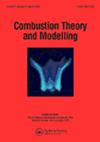内弹道两相流的高效二维粒子元法
IF 1.6
4区 工程技术
Q4 ENERGY & FUELS
引用次数: 0
摘要
随着内弹道计算需求的增加,降低计算成本具有重要意义。寻求一种更有效的内弹道仿真方法是内弹道仿真的关键。本文提出了一种高效的二维粒子单元法(PEM)来模拟气体和推进剂颗粒在燃烧室内的多维流动。首先,将几个真实粒子作为粒子单元进行填充,以减少固相的计算量。特别地,建立了粒子元矩阵来描述粒子参数的分布。其次,根据粒子的运动调整粒子元边界,减少网格生成的计算成本;采用动态自适应网格映射法实现气相与粒子元的耦合计算。采用标准虚拟枪作为内弹道码的标准基准,在误差为1.68%的情况下验证了该方法的准确性和可靠性。颗粒单元模型准确地描述了腔室内流场的分布。与双流体方法相比,PEM计算效率显著提高21.7%。PEM在快速模拟内弹道两相流中具有广阔的应用前景。本文章由计算机程序翻译,如有差异,请以英文原文为准。
Efficient two-dimension particle element method of interior ballistic two-phase flow
Reducing the calculation cost is of great importance as the demand for interior ballistic calculation is increasing. The key factor of interior ballistic simulation is the quest to develop a more efficient method. In this paper, an efficient two-dimension particle element method (PEM) is proposed to simulate the detailed multidimensional flow of the gas and propellant particle in the chamber. Firstly, several real particles are packed as the particle element to reduce the calculation of the solid phase. In particular, the particle element matrix is established to describe the distribution of particle parameters. Secondly, the particle element boundary is adjusted according to the particle’s movement to reduce the computational cost of grid generation. Besides, the dynamic self-adapting mesh map method is adopted to realise the coupling computation between gas phase and the particle element. The application of a standard virtual gun as a standard benchmark for interior ballistic codes is used to validate the accuracy and reliability with 1.68% error. The particle element model accurately describes the distribution of flow field in the chamber. Compared with the two-fluid method, the PEM significantly improves the computational efficiency by 21.7%. The PEM may be promising for the rapid simulation of two-phase flow in interior ballistic.
求助全文
通过发布文献求助,成功后即可免费获取论文全文。
去求助
来源期刊

Combustion Theory and Modelling
工程技术-工程:化工
CiteScore
3.00
自引率
7.70%
发文量
38
审稿时长
6 months
期刊介绍:
Combustion Theory and Modelling is a leading international journal devoted to the application of mathematical modelling, numerical simulation and experimental techniques to the study of combustion. Articles can cover a wide range of topics, such as: premixed laminar flames, laminar diffusion flames, turbulent combustion, fires, chemical kinetics, pollutant formation, microgravity, materials synthesis, chemical vapour deposition, catalysis, droplet and spray combustion, detonation dynamics, thermal explosions, ignition, energetic materials and propellants, burners and engine combustion. A diverse spectrum of mathematical methods may also be used, including large scale numerical simulation, hybrid computational schemes, front tracking, adaptive mesh refinement, optimized parallel computation, asymptotic methods and singular perturbation techniques, bifurcation theory, optimization methods, dynamical systems theory, cellular automata and discrete methods and probabilistic and statistical methods. Experimental studies that employ intrusive or nonintrusive diagnostics and are published in the Journal should be closely related to theoretical issues, by highlighting fundamental theoretical questions or by providing a sound basis for comparison with theory.
 求助内容:
求助内容: 应助结果提醒方式:
应助结果提醒方式:


